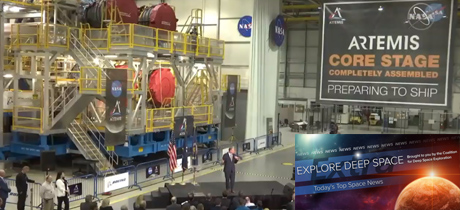In Today’s Deep Space Extra… NASA’s Space Launch System (SLS) has achieved a key milestone with assembly of the first core stage now complete, NASA Administrator Jim Bridenstine declared on Monday. The Mobile Launch Platform at NASA’s Kennedy Space Center (KSC), which will hold the SLS and the Orion crew capsule as they are launched, also marked a milestone. Astronomers find nearby stars slinging comets our way.
Human Space Exploration
Bridenstine proclaims SLS core complete “go SLS”
Coalition Members in the News – Aerojet Rocketdyne, Boeing, Northrop Grumman, United Launch Alliance
Spacepolicyonline.com (12/9): NASA Administrator Jim Bridenstine declared the core stage of NASA’s first Boeing developed Space Launch System (SLS) rocket complete during a gathering of workers, Congressional representative and local elected officials at the Michoud Assembly Facility in New Orleans on Monday. The 212 foot long core now moves on to NASA’s Stennis Space Center, where it will undergo pre-launch testing, including a full duration firing of the four Aerojet Rocketdyne first stage rocket engines. A target launch date for the first test flight, Artemis 1, is still under assessment. A second test flight, Artemis 2, with a second SLS will include astronauts aboard the Orion crew vehicle.
NASA chief shows off 1st core stage of new Space Launch System (SLS) megarocket
Coalition Member in the News – Boeing
Space.com (12/9): NASA Administrator Jim Bridenstine and Doug Loverro, the agency’s new associate administrator for human exploration and operations, led a celebration Monday at the agency’s Michoud Assembly Facility in New Orleans marking completion of the first Boeing manufactured Space Launch System (SLS) core stage. The 212 foot-long, four engine core will move out before the end of the year to NASA’s Stennis Space Center in Bay St. Louis, Mississippi, where it will undergo tests that include a full duration firing of the main engines. Then, it’s on to NASA’s Kennedy Space Center (KSC) for Artemis 1, the first joint test flight of the SLS and Orion on an uncrewed multi week mission around the Moon and back to Earth, possibly in 2021. “Think of it as NASA’s Christmas present to America,” said Bridenstine of the first SLS core complete.
NASA EGS completes first SLS Mobile Launcher fueling tests
Coalition Member in the News – Jacobs
NASAspaceflight.com (12/6): At NASA’s Kennedy Space Center (KSC), Exploration Ground Systems personnel and support contractor Jacobs have demonstrated liquid hydrogen and oxygen propellant flows between the refurbished Launch Complex 39B and the Mobile Launch Platform 1, which will be used for future Space Launch System (SLS) missions.
Space Science
Blue Origin gets set to send thousands of postcards to space and back on test flight
GeekWire.com (12/8): Blue Origin plans an early Tuesday launch of its New Shepard suborbital rocket from facilities in West Texas. The flight will be the 12th for the rocket, which is being developed to carry passengers, possibly starting in 2020. A 9:30 a.m., EST, liftoff is planned, though weather could be a factor. Many of the payloads are flown under NASA’s Flight Opportunities program.
Astronomers see stars slinging comets at Earth for the first time
Space.com (12/9): In a first, Polish astronomers have observed two stars fling orbiting comets towards our solar system. More than 600 stars within 13 light years of the Earth.
Other News
Catalyzing space debris removal, salvage, and use
The Space Review (12/9): A multi-authored assessment suggests establishing an intergovernmental, multi-lateral entity to deal with a mounting orbital debris threat to future low Earth orbit activities, including those that could include large numbers of people living and working in space. The proposal is a collaboration among three authors with backgrounds in foreign policy and investment banking.
How many spaceports are too many?
The Space Review (12/9): How many spaceports are too many? The FAA’s Office of Commercial Space Operations counts 11 active sites. Yet five have yet to host a launch. However, supporters believe the sites can serve as incubators for new technologies even if they are not launching but are wisely managed.

